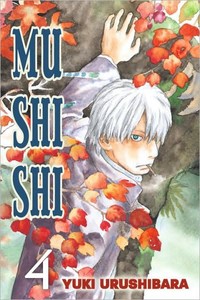Review
by Casey Brienza,Mushishi
GN 4
| Synopsis: |  |
||
Ginko is a mushishi, an expert on the powerful and primordial forms of life, more primitive even than bacteria, known as mushi. Mushi come in countless, myriad forms, and Ginko, whose powers mean that he cannot stay in one place for long, is ever on the move across the width and breadth of Japan, studying the mushi wherever he goes. In this volume, he explores mushi-laden mysteries surrounding a mountain imbued with life energy, a bamboo forest with some unusual inhabitants, a valley of zombies and magical bridges, a secret spring that places hapless human beings into an enchanted sleep, and a girl who gets lost within the otherworldly domain of the mushi. |
|||
| Review: | |||
Mushishi is not Yuki Urushibara's first manga. In years prior, she had produced a few select volumes for a now defunct small publisher under a different pen name, but these were, at best, modest efforts recognized or remembered by very few. In fact, it is quite likely that, had Mushishi not been accepted for publication by Kodansha's Afternoon, she would have quit manga creation entirely! Thank goodness she did not; what a terrible waste it would have been. Urushibara is easily one of the best, most subtle storytellers of her generation, and her achievement has been rightfully sanctified in the field with the receipt of both a Japan Media Arts Festival award in 2003 and a Kodansha Manga Award in 2006. Few manga series these days, even those that win the aforementioned awards, are genuinely literary, and Mushishi is one of those few. A dash of well-considered pseudo-science and deep wells of animistic Japanese tradition are woven together into a seamless tapestry that is at once wholly original yet mythic and timeless. Like many great science fiction authors before her, Urushibara seems to intuit the ebb and flow of scientific discovery. Why, just the other day, I was reading an article in the newspaper about the social life of plants! Who would have suspected that they have a social life? Even the ordinary is much more complex that we're wont to assume. And what about viruses? Are they alive? Or those self-replicating proteins called prions—are they? Perhaps the mushi aren't so far-fetched a notion after all. Anyway, mix that up with a human penchant for superstition (or spirituality, if you prefer), and next thing you know what we don't fully understand becomes Mushishi's pure magic. Indeed, at her very best, you really believe that Urushibara is somehow tapping into legends thousands of years old…and she is, though I doubt she necessarily realizes it. For example, volume four's “In the Cage” tells the story of an ordinary man who marries a supernatural woman who bears him a supernatural child and ultimately loses both to forces beyond his control. Such tales, broadly similar in outline, can be found in cultures on every continent and reveal preoccupations that haunt and unite all of humanity. Some are dark, while others resolve happily. All are unforgettable. Yet, at the same time, Mushishi feels earthy and culturally specific, its sense of place and closeness to nature strong throughout. The various characters appearing in each chapter—with the exception of Ginko, who remains a cipher with his white hair and green eyes—are humble and flawed, motivated by their simple needs. Everyone—again with the exception of Ginko, the only character in Western dress—wears kimono. The setting is that of a traditional, rural Japan, abounding in forests, dirt paths, rice fields, and timber-frame houses. It might have been the Japan of yesterday or of a hundred years ago; there is no modern technology or particular historical backdrop to give the reader any indication, so the manga should age gracefully. Alas, none of this is drawn especially skillfully, since Urushibara's only weakness is the stiffness of her design and expression, but the sequential art as such is entirely functional in its service to such an excellent series. The only real disappointment to be found anywhere pertains specifically to the Del Rey edition. Those familiar with the Japanese books, exceptionally beautiful objects of bound printed matter even by Japanese standards, are liable to look upon their American counterparts like poor cousins. Besides the exquisite watercolor covers, color art has not been reproduced, and some of the text bubbles are unreadable because they recede too deeply into the binding. In addition, each volume has been priced two dollars higher than most other Del Rey titles, perhaps in anticipation of weak sales and thin (or no) profit margins. But I doubt money was foremost in their minds. One Del Rey editor is on record saying that Mushishi “was something we had to do for the readers of tomorrow.” Read it and see for yourself why it's worth being handed down to the next generation. |
|
The views and opinions expressed in this article are solely those of the author(s) and do not necessarily represent the views of Anime News Network, its employees, owners, or sponsors.
|
| Grade: | |||
Overall : A
Story : A+
Art : B
+ Mainlines the power of myth into an elegant, tradition-laden Japanese setting. Simply unforgettable. |
|||
| discuss this in the forum (13 posts) | | |||
| Production Info: | ||
|
Full encyclopedia details about Release information about |
||